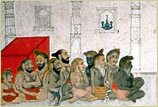|
Divine
in origin, invested with sacred duties and powers, the king
in ancient Indian philosophy was a manifestation of the gods
on earth. As such, he had very specific moral and public responsibilities,
and even his daily activities were spelled out in Hindu legal
texts such as the Arthashastra. Rajput kings ruled through
a network of kinsmen who governed different parts of the realm.
While the king retained symbols of authority, he also made
concessions for the family ties that bound him to his courtiers.
The Mughal ruler was viewed as God's shadow on earth, but
as Akbar's biographer says: "If he is an emanation of God's
light, how can we call him a shadow?" (The 'Ain-i-Akbari,
by Abul Fazl). Mughal emperors, partly to secure the loyalty
of their new subjects, claimed semi-divine status that raised
them above all others. In painting, with the reign of Jahangir
(1605-1627,) they acquired a nimbus, or halo. Hierarchy was
expressed in formal court occasions such as the royal audience
(darbar) but also in hunts and entertainments in which the
ruler's victory was assured and his glory reinforced. These
were occasions that rulers chose to document as they asserted
their power and the reaches of their domain. |
 Sangram
Singh with children in the Dilkhush Mahal
Sangram
Singh with children in the Dilkhush MahalRajasthan, Mewar
Opaque watercolor and gold on paper, ca. 1720
16 1/16 in. x 26 25/32 in. (40.8 cm x 68 cm)